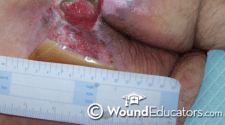Skin and Periwound Care- Part 1
Any patient with a wound is vulnerable to skin and periwound breakdown as well. There are several factors that clinicians must be aware of in order to help protect the periwound.
Why is the periwound vulnerable?
Because the periwound lies adjacent to a draining wound, it may be exposed to excessive amounts of moisture. Excessive moisture can cause this skin to soften, swell and become wrinkled, similar to how our fingers appear after a bath or swimming. When the skin soften, swells and wrinkles, it is more vulnerable to factors that may lead to breakdown of this vulnerable skin, including microbial factors (bacteria present in the wound), mechanical factors (friction and shear) and chemical factors (composition of wound exudate).
Risk factors for periwound breakdown
Some of the factors that can lead to breakdown of the vulnerable skin surrounding a wound include:
- Increasing age
- Environmental damage (such as exposure to ultraviolet light)
- Pre-existing skin disease (i.e. psoriasis or eczema)
- Congenital disorders (i.e. epidermolysis bullosa)
- Underlying pathology (i.e. lipodermatosclerosis)
Specific wound types carry their own risks related to periwound breakdown due to underlying pathology:
- Pressure ulcers- pressure ulcers of the sacrum are vulnerable due to the presence of urine and feces that may cause maceration; obese patients may have large skin folds that may harbor moisture and bacteria
- Diabetic foot ulcers- plantar ulcers are particularly vulnerable to maceration; incorrect dressing choice may also cause wound maceration
- Venous leg ulcers- patients with venous leg ulcers often have thin, dry skin and venous stasis dermatitis, making the periwound skin especially vulnerable to allergic/irritant reaction to wound care products and damage caused by use of adhesive dressings; in addition, these patients often have a significant amount of edema, which may cause maceration (the skin directly below the wound is most vulnerable, owing to gravity)
There are also numerous wound-related factors that may increase the risk of periwound damage. These include:
- Fistulae drainage
- Drainage from a stoma
- Excessive perspiration
- Removal of adhesive products
- Sensitivities (irritant or allergic reactions)
- Increased or excessive wound exudate- this may be caused by improper dressing use (using dressings that are not able to manage a high level of exudate) or failure to change dressings frequently enough. Exposure to proteases found in wound exudate can cause damage to the healthy skin, resulting in red, irritated or weeping skin. In the worst case scenario, exposure to exudate may lead to further skin breakdown and enlargement of the original wound.
- Maceration-occurs when moisture is trapped against the skin for prolonged periods; it is caused not only by excessive exudate, but also by exposure to excessive perspiration or urine. Maceration is dangerous because it can lead to enlargement of the wound.
- Skin stripping- this is caused by repeated application and removal of adhesive products, which damages the uppermost layers of the skin and may lead to edematous changes, inflammation of the skin, pain and loss of the skin barrier function
As can be seen, there are numerous factors that can lead to periwound skin breakdown. Anticipating these factors will allow you to avoid this problem. In part 2 of this article, we’ll examine methods to avoid periwound skin damage and breakdown.
If you enjoyed this article, you may consider becoming certified as a wound care professional. Wound Educators is the premier online wound education site, preparing professionals to become nationally certified. If you would like to learn more about becoming a certified wound care professional, please contact us.
Sources:
Moisture-Associated Skin Damage (MASD). Wound Source. http://www.woundsource.com/patientcondition/moisture-associated-skin-damage-masd
Lawton, S. & Langoen, A. (2009). Assessing and managing vulnerable periwound skin. World Wide Wounds. http://www.worldwidewounds.com/2009/October/Lawton-Langoen/vulnerable-skin-2.html


I have a male resident, bilateral aka, that has a left ischial wound that we have been trying to heal for almost one year. He has multiple co-morbidities and is refusing to eat. Complicating the situation is that he is oozing stool almost continuously and soiling the dressing. We have used multiple treatments, the last being a wound vac. We are currently trying raw honey and sugar mixture but with the constant soiling we are not seeing any improvement. Can you suggest anything that we might try to get this wound resolved once and for all.
I recommend finding a wound care specialist to assess these types of wounds. To locate a wound care specialist visit: https://portal.abwmcertified.org/ABWMweb/Directory/ABWMcontent/Directory.aspx
Thankfulness to my father who shared with me concerning
this weblog, this web site is actually remarkable.